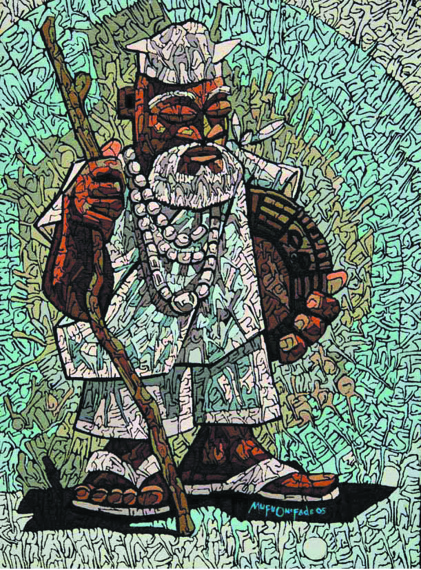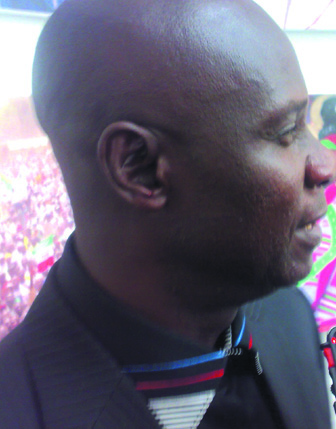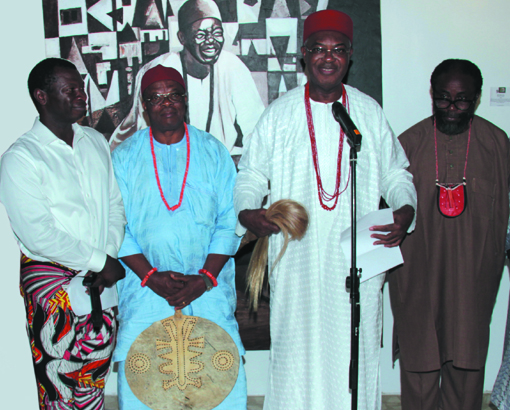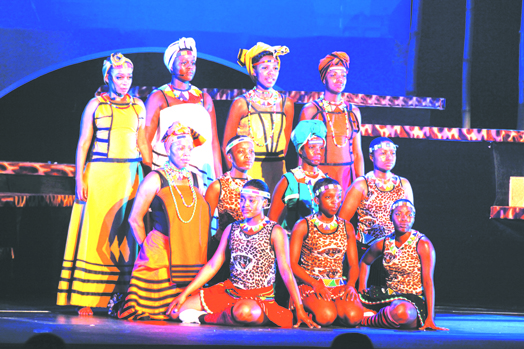Among friends and associa tes, he is the multi-media communicator, more for his versatility in the various genres of the art where he is not just player but an accomplished practitioner, Mufu Onifade is very much at home on the art turf as a dramatist, playwright, journalist, painter, recording artiste, and now a policy influencer by virtue of his new robe as special assistant on media to the Director General of the National Gallery of Art (NGA). In this chat with VICTOR NZE, Onifade explains events that have shaped his life and career, and many more. Excerpts:
tes, he is the multi-media communicator, more for his versatility in the various genres of the art where he is not just player but an accomplished practitioner, Mufu Onifade is very much at home on the art turf as a dramatist, playwright, journalist, painter, recording artiste, and now a policy influencer by virtue of his new robe as special assistant on media to the Director General of the National Gallery of Art (NGA). In this chat with VICTOR NZE, Onifade explains events that have shaped his life and career, and many more. Excerpts:
Congratulations on your recent appointment as Special Assistant on Professional Matters to the Director-General of the National Gallery of Art; but now tell us in your own choice of words, who is Mufu Onifade?
Thanks a lot…particularly for your media support over the years. To answer your question: Mufu Onifade is an artist, by training and by practice. He is a total artist. He is what a senior colleague once called “multi-media communicator”. I am into all areas of art – visual, literary, performing and reproduction. But I feel much more comfortable to simply introduce myself as an artist. My academic training was in Fine Arts, with specialisation in Painting, but I also had informal training in Theatre, Performance and Writing. So, Mufu Onifade is an artist.
How would you explain your versatility in the arts?
I started my foray into the arts from virtually all fronts at the same time. I did a lot of drawings in my primary school. I was into the sport of boxing while I was learning the the vulcanizing job in Ebute-Ero, Idumota, Lagos Island. At a point, I had to jettison boxing for art when I met someone we called Art Master. In my secondary school, I became the Social Prefect. I also held a number of posts at the same time. I was President, Art Club; President, Dramatic Society; the School’s Chief Cartoonist, and many more. But I was more outstanding in Art Club, Dramatic Society and as Social Prefect. I led my school to art competitions and won prizes.
I also won first prize in Art from Class 2 to 5 when I passed out in 1985. In 1984, the Lagos State Government organised what was called Lagos State Secondary Schools Drama Competition. I wrote my school’s play titled The Consequence of Truancy. We eventually won second prize and that meant a lot to us at the time. Our school was less than five years old, and we were able to beat many long-established schools. That was our joy. So, all along, I have combined all areas of the arts.
I joined the Lagos State Council for Arts and Culture in 1985 – both as a visual/performing artist. I had the privilege of working with masters of the game like Tunji Oyelana, Yomi Obileye, Funmi Odusolu, late Segun Taiwo, Biodun Ayoyinka (Papa Ajasco). We were effectively coordinated by the firebrand Gbenga Sonuga (now Oba Gbenga Gbadebo Sonuga – the Fadesewa of Simawa). We travelled all over Nigeria and later went on tour of the United States in 1986. That was the golden era of the Lagos Arts Council. There can never be another director like Gbenga Sonuga, mark my word. All of us who went through him then are doing very well today. We remain eternally grateful to him for the training.
Incidentally, I had never been conscious of my versatility. As far as I was concerned, I was merely practising my passion. I have always had passion for everything I do. Luckily for me, writing, painting, performing and all come to me naturally. So, I don’t really have to squeeze myself to do it. And it’s even difficult for me to explain how I have managed to harnessed all these areas of the arts. All I know is, I have never done anything outside the arts. My life revolves around the arts and I feel fulfilled being in it.
You’ve been in the arts sector for 3 decades or thereabout, what would you define as the highpoints and challenges of the industry?
For me, the inability of the Government to implement the Cultural Policy has been a major setback for the arts. The issue of endowment funds for the arts has been a major one not being addressed by many governments. In Theatre, the National Theatre is being run in a way that impedes on steady progress of the industry, and the practitioners are not finding it funny at all. In visual art, we do not have an infrastructure – an exhibition space called National Gallery. This is a major challenge particularly to the Nigerian artist who has to, in most cases, depend on shylock private galleries to survive. In Literary Art, we all know that our reading culture is in a shamble. You just wonder where we got it all wrong. However, you must agree with me that the highpoints of Nigerian arts dates back to FESTAC ’77. We should have latched on to that and develop on it. All the same, we need to recognise the efforts of stakeholders, particularly various associations which have initiated projects that constantly remind us of the invincibility of our arts. For me, I look into the future when we would have a true National Theatre that is run with serious consideration accorded the stakeholders. I dream of our own National Gallery where anybody from any part of the world can walk in to enjoy the best of Nigerian creative products. A National Gallery where we can see the works of great artists like Aina Onabolu, Akinola Lashekan, Ben Enwonwu, Lamidi Fakeye, Agbo Folarin, Uche Okeke, Obiora Udechuckwu, Demas Nwoko, and so on. I dream to witness in my lifetime, a National Gallery where the best of our paintings, sculptures, ceramics, textiles, graphics and drawings can be viewed with relish.
Recent newspaper publications have levelled serious allegations against your person, could you clear the air on some of these supposed misrepresentation?
Well, it was Kunle Adeyemi’s trademark propagation of lies published in The Guardian of Friday, 2 March 2012 titled ‘Conspiracy and Trials in NGA…. Visual Arts, Artists are greatest losers’. He wrote and I quote: “Sponsorship to Groups and Individual Artists: The group of artists under the nomenclature, ‘Araism’ led by Mufu Onifade received consecutive sponsorship for two years within this period to the tune of N750,000 each”. He claims I got the money from NGA under the embattled former director-general, Mr. Joe Musa.
How can a professed scholar be so bold in selling blatant lies to the public? Where and how did he (Adeyemi) get this misleading information? What or who was his source? He claimed to get his facts from National Gallery. Which one? The same National Gallery where I work as SA to DG? Adeyemi is a pathological liar who is being used for selfish purposes.
The truth is that the National Gallery under then former Director General Chief Joe Musa did not release funds to Araism led by Mufu Onifade. The said money – seven hundred and fifty thousand naira – was released in 2008 to Ara Studio, an arts-based outfit that requested for, got the funds and packaged a memorable event marking the 10th anniversary of Araism as a painting technique. Indeed, 2008 marked the 10th anniversary of Araism as a painting technique, which I had single-handedly invented through dedicated and thorough studio experiments. The launching of the technique in 1998 was predicated on the success of the experiments which began in 1989 and terminated in 1996. As at 2008, Araism as a painting technique had attracted many exponents, and this, for proper coordination of their activities, led to the establishment of the Araism Movement in 2006. This had occurred two years prior to the 10th anniversary of Araism as an authentic African painting technique. Araism is our genuine contribution to the development of Nigerian art and we had no cause to shy away from requesting for funding from the National Gallery of Art for the sole purpose of celebrating the 10th anniversary of Araism.
 You will agree with me that N750, 000 (seven hundred and fifty thousand naira) is a meagre sum considering the elaborate nature of the event. Titled Araism: African Ideals and Authenticity of Creativity in Contemporary Nigerian Art, the event was an open seminar chaired by Nigeria’s quintessential art historian, Prof. Ola Oloidi (of the University of Nigeria, Nsukka) and moderated by co-ordinator of the Committee for Relevant Arts (CORA), Mr. Toyin Akinosho. Keynote address was delivered by Prof. Ahmed Yerima (the then Director-General of the National Theatre/National Troupe of Nigeria). Other scholars and guest speakers include Dr. Kunle Filani (Federal College of Education, Osiele, Ogun State), Dr. (Mrs.) Bridget Nwanze (University of Port Harcourt), Dr. Ken Okoli (Ahmadu Bello University, Zaria), Dr. Ronke Adesanya (University of Ibadan) and Dr. Hellen Uhunmwangho (Federal Polytechnic, Auchi). The seminar, which was held at the Cinema Hall 2 of the National Theatre, Lagos was also graced by major stakeholders and heavyweights in the culture sector: Ambassador Segun Olusola, Chief Rasheed Gbadamosi, Mr. Sammy Olagbaju, Mr. Kolade Oshinowo who won a special recognition award at the event and students from virtually all art schools across Nigeria. It was a big celebration that enjoyed robust supports from every participant.
You will agree with me that N750, 000 (seven hundred and fifty thousand naira) is a meagre sum considering the elaborate nature of the event. Titled Araism: African Ideals and Authenticity of Creativity in Contemporary Nigerian Art, the event was an open seminar chaired by Nigeria’s quintessential art historian, Prof. Ola Oloidi (of the University of Nigeria, Nsukka) and moderated by co-ordinator of the Committee for Relevant Arts (CORA), Mr. Toyin Akinosho. Keynote address was delivered by Prof. Ahmed Yerima (the then Director-General of the National Theatre/National Troupe of Nigeria). Other scholars and guest speakers include Dr. Kunle Filani (Federal College of Education, Osiele, Ogun State), Dr. (Mrs.) Bridget Nwanze (University of Port Harcourt), Dr. Ken Okoli (Ahmadu Bello University, Zaria), Dr. Ronke Adesanya (University of Ibadan) and Dr. Hellen Uhunmwangho (Federal Polytechnic, Auchi). The seminar, which was held at the Cinema Hall 2 of the National Theatre, Lagos was also graced by major stakeholders and heavyweights in the culture sector: Ambassador Segun Olusola, Chief Rasheed Gbadamosi, Mr. Sammy Olagbaju, Mr. Kolade Oshinowo who won a special recognition award at the event and students from virtually all art schools across Nigeria. It was a big celebration that enjoyed robust supports from every participant.
The outfit did not get 750,000 twice. There was only one-time funding in that sum, not twice as maliciously claimed by Adeyemi. The second funding either only exists in the imagination of Adeyemi or was cooked for him to swallow by those who employed him and bought over his conscience for mere media propaganda. I am constrained not to mention anything about the much-touted Art Expo Las Vegas (an international art exhibition, which Joe Musa led us to) whose ripples of corrupt practices are still causing a widening gap between the artists and Joe Musa’s National Gallery of Art. The purported show came and ended with a stinking can of worms. Adeyemi was not in Las Vegas; so, he didn’t know my role in pacifying aggrieved artists like Abiodun Olaku, Ben Osaghae, Abraham Uyovbisere, and others.
For record purpose, it is important for the members of the public to know that Ara Studio’s partnership with Joe Musa’s National Gallery of Art wasn’t a germane effort. Those of us who believe in the progress of the visual art sub sector have always partnered with the National Gallery of Art. I remember vividly that a similar collaboration in the aspect of seminar, had happened between Ara Studio and the National Gallery of Art under the dynamic leadership of Dr. Paul Chike Dike way back in 2006. That seminar was titled When Does an Artist Become a Master? Dr. Dike, who is loved by all for his dynamic leadership and progressive tendencies, fell in love with the idea of interrogating such an important provocative issue that many art scholars had never thought of. So, without hesitating, the National Gallery’s action, courtesy of Dr. Dike’s soft heart for progress and development of Nigerian art, was pronto! The seminar hosted paper presentations by respected art scholars and promoters including Prof. Bruce Onobrakpeya, Dr. Peju Layiwola, Mr. Nsikak Essien, Mr. Moses Ohiomokhare and others? It was successfully moderated by Oba Gbenga Sonuga and dedicated to one of Nigeria’s finest scholars and art practitioners, Prof. Yusuf Grillo. The seminar even coincided with the publishing of a voluminous book in honour of Prof. Grillo, titled Yusuf Grillo: Master of Masters.
When Dr. Dike left the office, I’m sure he never went as parochial as Adeyemi has done on behalf of Joe Musa, by creating unfounded propaganda and debasing our genuine intention. Despite his staggering achievements, I don’t think he has ever gone to Press either to blow his own trumpet or even placing someone on his pay roll to reel out his achievements.
Still for the records: Ara Studio has also partnered on various other germane creative ideas with such other government agencies as the National Theatre, Centre for Black and African Arts and Civilization (CBAAC), National Institute for Cultural Orientation (NICO), and so on. It was these monumental legacies of successful delivery, credibility and integrity that attracted the partnership from Joe Musa’s National Gallery of Art – and this should not be courted and exploited for blind ambition and propaganda as being perpetrated by Adeyemi.
As a bona fide member of the Society of Nigerian Artists and a professional artist, I know and I am bold to say that Adeyemi’s views, which were falsely expressed in The Guardian and The Nation newspapers do not represent the thinking and standpoint of an average Nigerian artist. It is a personal agenda arising from discharge of his allegiance to those who have placed him on their payroll to scuttle the relative peace that we now enjoy in the visual art sub sector.
What is the future like for Nigerian arts in general and the visual arts sector in particular?
Honestly, I see a very, very bright and robust future. The visual art sub sector is already exploding. Do you know what the numerous auctions have done for Nigerian art? Galleries now know they have to sit up and do things properly. The venture is becoming much more lucrative. People are now aware that you can earn big and live big as a visual artist. It will only get better.
Do you see yourself as a recording artiste one day, since that remains the only uncharted path for you in art?
I have already recorded my music with a working title; Adun Ife (Sweetness of Love). It’s a traditional genre, folk music of sort. It involves traditional tonal poetry and original folk songs – not any of those existing ones. The hallmark of the piece is its originality. I have done the recording since 2004, but I haven’t been able to put minds together to complete work on it. I believe we can get it sorted out before the end of the year. As soon as I hand over as Chairman of the National Association of Nigerian Theatre Arts Practitioners (NANTAP-Lagos Chapter), I will have enough time to myself to pursue various aspects of my career. I will have enough time to paint and up my living standard.
 Executive Secretary of the National Institute for Cultural Orientation (NICO), Dr. Barclays Foubiri Ayakoroma, has been nominated for the Goodwill Ambassador Award of the University of Calabar (UNICAL) by the Governing Board of the University.
Executive Secretary of the National Institute for Cultural Orientation (NICO), Dr. Barclays Foubiri Ayakoroma, has been nominated for the Goodwill Ambassador Award of the University of Calabar (UNICAL) by the Governing Board of the University.

















